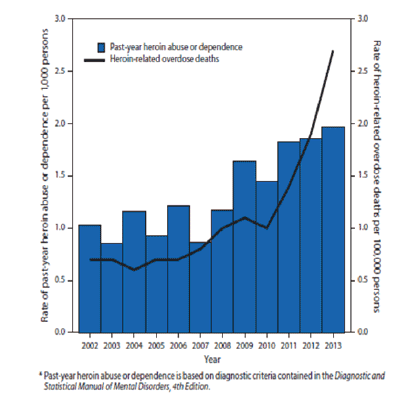
Figure 1: Rates of past-year heroin abuse or dependence* heroinrelated overdose deaths – United States, 2002-2013

Emil Joseph*
Touro College of Pharmacy, New York, USA*Corresponding author: Emil Joseph, Touro College of Pharmacy, New York, USA, E-mail: ejoseph3@student.touro.edu
By today’s standards, the ability to abuse prescription drugs in the United States such as opioids has been challenged by various measures used to regulate controlled substance prescribing. Contributing initiatives include opioid misuse risk mitigation methods, insurance limitations and Prescription Monitoring Programs appointed to each state [1]. Risk mitigation strategies have been designed to help reduce the use of opioids for nonmedical purposes. Insurance companies set dosing limitations on opioid agents and may require prior authorizations for some formulations. As of August 27, 2013, all prescribers in the state of New York are required to consult the state PMP Registry when writing prescriptions for Schedule II, III and IV controlled substances. The state registry provides prescribers with direct yet secure access to view the controlled prescription histories of patients. These measures have not completely eliminated the existence of opioid abusers but have further regulated prescribing practices of these agents, making it more difficult for abusers to divert.
Considering the regulations set in place, opioid abusers may resort to other measures to supplement their addiction. In relation to the National Survey on Drug Use and Health (NSDUH) of 2013, an increase of the illicit use of heroin was verified as the nonmedical use of prescription opioids decreased. According to the Centers for Disease Control and Prevention (CDC), annual average rates of past-year heroin use increased from 1.6 per 1000 persons ages ≥ 12 in 2002-2004 to 2.6 per 100 persons in 2011- 2013. With regards to the statistics between 2011 and 2013, the highest odds of heroin abuse were amongst those who had a past-year history of cocaine and/or opioid abuse or dependence (Figure 1). The percentage of heroin users with history of opioid abuse more than doubled from 20.7% in 2002-2004 to 45.2% in 2011-2013. By 2011-2013, opioid abuse or dependence was more common amongst heroin users than alcohol, marijuana or cocaine abuse or dependence [2].

Figure 1: Rates of past-year heroin abuse or dependence* heroinrelated overdose deaths – United States, 2002-2013
Early reports from local drug monitoring systems throughout the U.S. have reported the pathway between opioid use and heroin. Both the increased availability and lower price of heroin in the United States have been identified as potential contributors to the rising numbers of heroin users. This trend is also attributed to the regulatory changes reducing the availability of prescription drugs for nonmedical use. During a qualitative study performed amongst heroin injectors in Philadelphia and San Francisco, opioid initiates typically reported switching to heroin from opioids for reasons of cost and ease-of-access after becoming physically and emotionally dependent on opioids. Amongst a sample size of 22 heroin abusers, a few users had been prescribed oral opioids for pain relief until their physical and/or emotional dependence surpassed their prescribed supply or limit [3]. The other users reported most of the other opioid sources reported in the Substance Abuse and Mental Health Services Administration (SAMHSA 2012) survey such as receiving, purchasing or even stealing from a relative or friend [4]. In addition to this association, regional studies have suggested that opioids serve as a ‘gateway drug’ for some abusers, especially those who have become dependent on Oxycontin, the extended-release formulation of Oxycodone [3].
These statistics highlights how the controlled demand of one substance may stimulate the use of another harmful substance. In this case, we see that opioid abuse, which is already a problematic factor, is accompanied by the potential for heroin abuse. Furthermore, the very laws and regulations that limit opioid abuse serve as contributing factors to the heroin statistics. The implications made by the aforementioned studies prove that while the battle against opioid abuse has resulting in some victory, there are major shortcomings. In other words, additional research is necessary to further analyze the problem so that we may reach an appropriate solution. This calls for us as pharmacists to take the appropriate measures to assess substance abuse in our communities. We must take action by analyzing patients’ controlled substance history using the appropriate PMP Registries, providing adequate counseling to patients when dispensing medication and communicating closely with prescribers. In addition, we should be able to recognize and understand aberrant behaviors amongst potential drug abusers. Furthermore, we must be ready and willing to provide members of the community with viable information towards receiving appropriate care and services. By doing so, we may equip our communities with the appropriate tools to confront substance abuse of any nature.
Download Provisional PDF Here
Article Type: Short Communication
Citation: Joseph E (2016) Heroin use Stimulated by Strengthened Opioid Prescription Regulations. J Pharm Anal Insights 1(3): doi http://dx.doi. org/10.16966/2471-8122.109
Copyright: © 2016 Joseph E. This is an openaccess article distributed under the terms of the Creative Commons Attribution License, which permits unrestricted use, distribution, and reproduction in any medium, provided the original author and source are credited.
Publication history:
All Sci Forschen Journals are Open Access